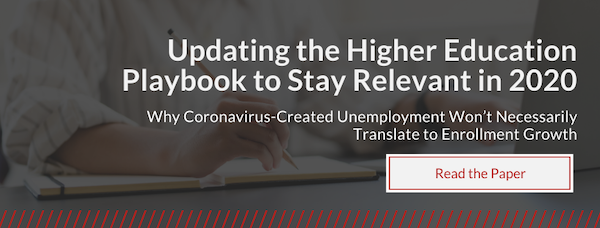Published on
Integrating Employer Engagement with Experiential Learning in Response to the New Normal

COVID-19 has forced every college and university to re-evaluate its value proposition as more and more of the traditional student experience moves online or remotely. One part of the value proposition many institutions have relied on is the opportunity for learners to gain work experience while earning a degree by participating in co-ops or internships outside the classroom. Traditionally, this has been the means for learners to gain confidence, acquire resume credentials, expand networks, and achieve career aspirations all while completing degrees.
But the pandemic forced many industries to opt for remote work and scale back on such experiential engagements with colleges and universities. Suddenly, traditional work experiences have become harder to sustain for businesses and schools alike. In fact, Forbes reported that the coronavirus might be the greatest catalyst for business transformation in modern times, and the general sense is that it will transform higher education just as dramatically, particularly in experiential learning.
The truth is, even pre-pandemic some traditional approaches to experiential learning were showing their age, giving way to flexible options more accessible to the growing non-traditional learner population, well-aligned with the emerging gig economy and the expansion of the digital workplace. The COVID-19 crisis hastened higher education’s march toward offering more options for students’ experiential engagement and employer partners. Moreover, by taking a quick look at the challenges higher education faced pre-pandemic, it’s easy to see why many schools were already on the lookout for solutions to meet employers’ evolving needs and expand the array of experiential learning for tuition-paying learners.
For starters, non-traditional learners make up over 70% of the U.S. college population, yet experiential engagements at most schools are aimed at traditional learners, leaving an experiential gap for many. Further, the National Association of Employers and Colleges (NACE) reported that employers expect the equivalent of 18 months of related work experience from recent graduates seeking entry-level jobs. But how do learners gain that amount of experience from current approaches in traditional degree programs? Likewise, a McGraw Hill survey reported that only 41% of college students felt well-prepared for their future careers. In fact, 51% said they needed more experiential learning opportunities from their schools, not fewer! Now add a global pandemic that shuttered many businesses and forced others to go virtual and an already challenging scenario became even more difficult for learners looking to get experience.
A recent NACE survey on the pandemic reported that 22% of employer respondents were revoking offers to interns and 19% more remain undecided about what they plan to do for summer 2020 and beyond. Of the employers who decided to continue their internship programs, most adopted a virtual format until further notice. One thing is certain, NACE reports, 83% of employers intend to make significant changes to their internship programs going forward, meaning virtual work will likely play a larger role.
What does that mean for the future of experiential learning and the employer engagement required to sustain it? It doesn’t have to mean a harsher reality, but it should require new approaches. And this is where forward-thinking post-secondary institutions come to the rescue.
What the new normal requires is the true integration of employer engagement and experiential learning. In the past, these two activities were somewhat siloed or narrowly focused, though they are largely co-dependent. Nowadays, the way an institution leverages employer engagement in support of experiential learning will be key to upholding its value proposition of giving learners the chance to apply classroom skills in the real-world workplace.
This new integration means institutions must intentionally partner with employers to begin constructing the talent pipeline almost right from the beginning of a learner’s journey, not just during the last mile when students are about to graduate. In a 2018 report for the U.S. Chamber of Commerce, Burning Glass identified a lack of alignment between the skills employers need and the available talent emerging from colleges. Burning Glass noted the need for expanded, more intentional employer partnerships in higher education as a reason for this misalignment. At the time, Burning Glass reported that there were 4.4 million more jobs than workers in industries like health care, computer technology, sales, and business and finance due to this gap. Of course, that picture has changed since COVID-19 hit, leaving 36 million people unemployed. However, even during the Great Recession, demand for skilled workers in technology and health services exceeded supply by 5%, and current evidence suggests a significant shortage of skilled workers remains, meaning the gap between rising professionals’ skills and job market needs persists, even in tough times like these.
Therefore, we need more institutional-employer partnerships, aligned with in-demand academic programs and embedded with an array of opportunities for hands-on experiences to make graduates competitive in the current labor market. This means that, along with co-op and internships, we need innovative, flexible and accessible options for experiential learning that are as flexible and accessible as the shorter-term, bite-size online certifications and micro-credentials trending in academic programs. This is where the idea of micro-internships comes from schools looking for ways to expand experiential offerings beyond onsite internships. Micro-internships are discreet project-based professional assignments formerly completed by traditional full-time interns in much longer time frames and at much higher costs. The experience companies like Parker Dewey or Riipen offer students are good examples of this model and help fill the gap left by traditional internships lost to the pandemic.
At my own institution, Northeastern University, we have a robust history of employer engagement partnering with over 3,000 employers to support over 11,000 co-op learners annually as thousands more learners compound their studies with virtual project-based learning through our Experiential Network (XN). We’re responding to the new normal with innovative commitments to broaden and deepen employer engagement by optimizing talent acquisition and experiential strategies to meet employers’ evolving needs with more flexible options for co-op, virtual project-based learning, an array of online recruitment events, digital career fairs, on-demand virtual career design, online job interviewing and cloud platforms for student-employer connections.
The result is that many forms of engagement formally accomplished on-ground or in person are now delivered fully online in a flexible, adaptable and accessible manner–the way employers want it and need it these days. Along those lines, the pandemic did more than just awaken higher education and business from the old normal slumber. It put front and center the emerging need for both industry and higher education to look at how they were doing business with each other before and how they should be doing business in the future to their mutual benefit.
The tragedy of COVID-19 is enormous, but the disruption caused by this crisis has led us to a new purpose born of necessity for employer engagement at many institutions. The new normal stirred institutions worldwide to consider a flexible array of options for employers and learners to engage with each other and allowed employer engagement to power experiential learning.
Not all schools will be able to stay with this curve when it comes to addressing such rapid change. Many institutions may not have the established online strategies or adequate resources to deliver these multi-modal opportunities to learners on their own. For some, vendors like Parker Dewey and Riipen might be the right choice because of the immediacy they offer to bridge the experience gap for learners at schools seeing traditional internships dry up but without the means to stem this tide on their own. Therefore, each school must determine how it will respond to this challenge, measure its own obstacles, assess existing resources, gauge students’ needs and then execute a personalized strategy.
The important thing to remember in this rapidly changing landscape is that each institution must pursue a more flexible and accessible avenue for employer engagement in support of experiential work opportunities to help learners best achieve their career aspirations and bridge the gap between higher education and their first job (or next) jobs.
Disclaimer: Embedded links in articles don’t represent author endorsement, but aim to provide readers with additional context and service.
Author Perspective: Administrator




